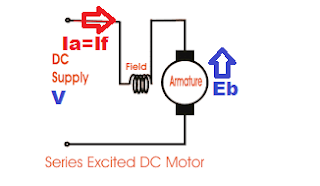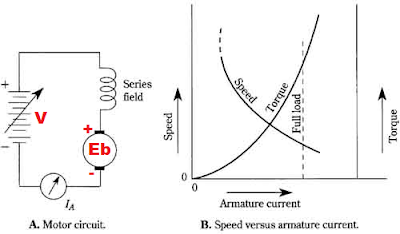The DC series motor attains dangerously high speed when we run it on no load. The main reason for overspeeding is that at no load, the flux produced by the field winding is much less, and the reduced flux causes overspeeding of the motor. The speed of the motor is inversely proportional to the flux.
In the DC series motor, the field and armature windings are connected in series, and both windings carry the same amount of current. The field winding has to carry the full-rated armature current. Therefore, the field coil has a few turns of thicker wire.
The speed of the DC motor is proportional to the back EMF(Eb) and inversely proportional to the flux. The flux is proportional to the field current.

In the DC series motor, the field current and the armature current are the same. Therefore, the flux in the motor is proportional to the armature current(Ia).
N=K1*Eb/Φ ———-(1)
N= Speed of the motor
Eb= Back EMF of the armature
Φ= Flux
K= constant
When the armature current flows, the armature inductance opposes it. To impede the armature current, the voltage of the opposite polarity to the applied voltage(V) is induced in the armature. The voltage induced in the armature is known as the back EMF(Eb).
According to Kirchoff’s current law, the algebraic sum of all the voltage around any closed loop in a circuit is zero.
V+Ia(Ra+Rf)+Eb=0 ———–(2)
Ra= The armature resistance
Rf= The field resistance
V= Applied Voltage
Eb= V-Ia( Ra+Rf) ————(3)
N=K1*Eb/Φ
Eb= NΦ ————–(4)
Putting the value of Eb of equation(4) in equation (3)
K1*NΦ= V-Ia( Ra+Rf)
N= [V-Ia( Ra+Rf)]/K1*Φ
N= [V-Ia( Ra+Rf)]/K1*K2Ia (Φ∝ If, or Φ∝ Ia as Ia=If) K2- Constant
N = [V-Ia( Ra+Rf)]/K1K2*Ia
N = V/K1K2*Ia-( Ra+Rf)]/K1K2
N= (V/K1K2)*1/Ia-( Ra+Rf)]/K1K2
N=K3*1/Ia-K4
Where K3(constant)=(V/K1K2)
K4(constant)=( Ra+Rf)]/K1K2
N=K3/Ia-K4 ———(5)
From equation (5), it is clear that the speed of the DC series motor is inversely proportional to the armature current.
The armature current v/s speed characteristics of the DC series motor are given below.

At no load, the armature current of the DC series motor is very low. If the motor is operated at no load, the motor will attain an enormously high speed that can physically damage the rocker arm assembly and the motor parts. This is the same case when the separately excited DC motor is started without switching on the field supply.
When the DC series motor is connected to the load at the start of the motor, the motor draws more armature current compared to the starting current with motor operation at no load, and the speed of the motor increases in a controlled way. The DC series motor must not be tested on no load condition.
For the above reasons, the DC series motor should not be started at no load.
Interesting to learn with you
You are good principal.